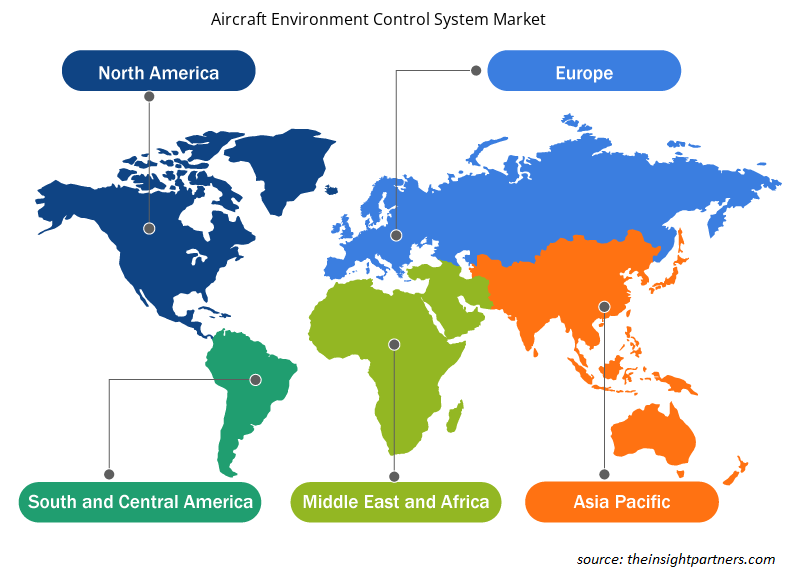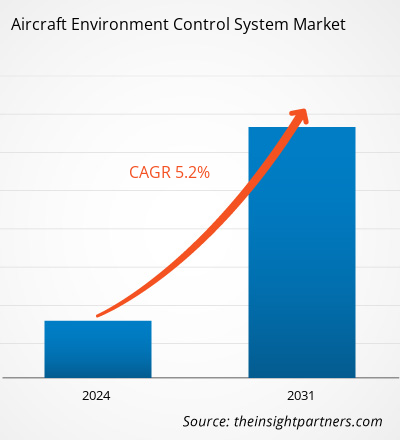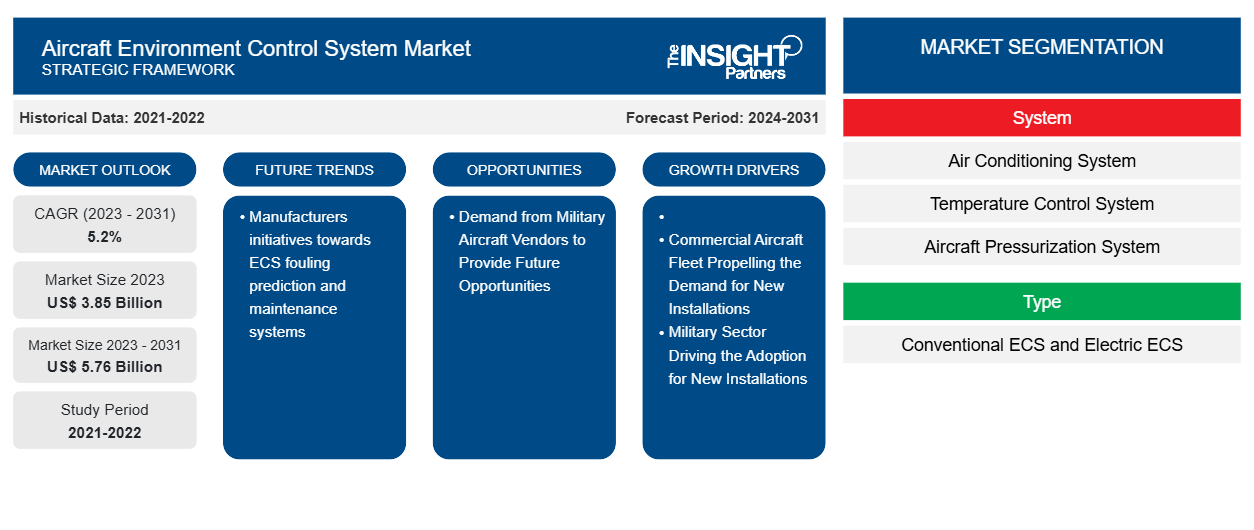Se proyecta que el tamaño del mercado de sistemas de control del entorno de las aeronaves alcance los 5.760 millones de dólares estadounidenses en 2031, frente a los 3.850 millones de dólares estadounidenses en 2023. Se espera que el mercado registre una CAGR del 5,2% entre 2023 y 2031. La industria de la aviación está experimentando un cambio de paradigma en términos de aviónica, sistemas de aire acondicionado, sistemas de presurización de cabina y motores, entre otros. Esto se debe principalmente a la mejora de la seguridad de las aeronaves, los pasajeros y la tripulación. El enfoque cada vez mayor hacia las medidas de seguridad entre las aerolíneas, los fabricantes de aeronaves, las autoridades gubernamentales y los fabricantes de componentes está abasteciendo los negocios de los fabricantes de componentes de aeronaves.
Análisis del mercado de sistemas de control del entorno de las aeronaves
Los principales interesados en el mercado de ECS para aeronaves son los proveedores de materias primas, los fabricantes de ECS, los MRO y los fabricantes de aeronaves. Los proveedores de materias primas suministran aluminio, cobre, entre otros, a los fabricantes de ECS. Estos proveedores de materias primas se enfrentan regularmente a una enorme presión por parte de las empresas de fabricación de ECS para que entreguen materias primas de alta calidad. El valor de marca de los proveedores de materias primas es de suma importancia, ya que la calidad del material es esencial para las empresas de ECS para aeronaves. Con el objetivo de mantener relaciones comerciales a largo plazo, los proveedores de materias primas se esfuerzan por entregar materiales de la más alta calidad a un precio competitivo. Las empresas de ECS para aeronaves fabrican ECS para fabricantes de aeronaves y MRO. Las empresas de MRO tienen una demanda significativa de ECS para aeronaves debido a los altos requisitos de mantenimiento y reparación. Los fabricantes de aeronaves son el cliente clave de ECS para aeronaves. Se espera que el aumento en la fabricación de aeronaves cree una demanda significativa de ECS para aeronaves. Algunos de los actores clave de ECS para aeronaves son Boyd Corporation, Honeywell International, JAMCO Corporation y otros.
Descripción general del mercado de sistemas de control del entorno de las aeronaves
Es probable que el mercado de sistemas de control del entorno de las aeronaves experimente un sólido crecimiento en los próximos años. El crecimiento del mercado de sistemas de control del entorno de las aeronaves se atribuye a algunos de los siguientes factores:
- La flota de aviones comerciales impulsa la demanda de nuevas instalaciones
- El sector militar impulsa la adopción de nuevas instalaciones
- Necesidad emergente de controles ambientales efectivos dentro de las aeronaves durante las operaciones
Es probable que estos factores tengan un fuerte impacto positivo en términos de crecimiento del mercado de sistemas de control ambiental de aeronaves. La necesidad de contar con sistemas de calefacción y refrigeración eficaces para las aeronaves es otro factor importante que cataliza la demanda de nuevas instalaciones de sistemas ECS en la producción de aeronaves nuevas y en las flotas de aeronaves existentes de varias aerolíneas comerciales.
Personalice este informe según sus necesidades
Obtendrá personalización en cualquier informe, sin cargo, incluidas partes de este informe o análisis a nivel de país, paquete de datos de Excel, así como también grandes ofertas y descuentos para empresas emergentes y universidades.
- Obtenga las principales tendencias clave del mercado de este informe.Esta muestra GRATUITA incluirá análisis de datos, desde tendencias del mercado hasta estimaciones y pronósticos.
Factores impulsores y oportunidades del mercado de sistemas de control del entorno de las aeronaves
La flota de aviones comerciales impulsa la demanda de nuevas instalaciones
El aumento del número de flotas de aviones comerciales en varias regiones es uno de los principales factores que respaldan el crecimiento de los nuevos sistemas de control ambiental (ECS) en varios modelos de aeronaves. Además, en 2024, el tamaño de la flota mundial de aeronaves se sitúa en torno a las 28.398 unidades a nivel mundial, lo que ha experimentado un crecimiento del 3,7% desde el año pasado en términos de crecimiento de la flota en un solo año. Además, es probable que el tamaño de la flota de aviones comerciales alcance unas 36.413 unidades a finales de 2034, lo que probablemente impulse aún más el mercado de los sistemas de control ambiental (ECS) en los próximos años.
Demanda de los proveedores de aeronaves militares para brindar oportunidades futuras
El creciente número de despliegues de aeronaves militares, helicópteros y vehículos aéreos no tripulados en las fuerzas armadas de diferentes países es uno de los principales factores que probablemente generen nuevas oportunidades para la instalación de sistemas ECS en los próximos años. Esto también está respaldado por el aumento del gasto militar de diferentes países a nivel mundial que están gastando más en la adquisición de diferentes sistemas de aeronaves militares. Además, los fabricantes de sistemas de aeronaves militares también están trabajando en colaboración con sus respectivos clientes para comprender su demanda respectiva y brindarles soluciones ECS confiables para sus requisitos específicos. Por ejemplo, en diciembre de 2022, Pratt & Whitney y Collins Aerospace lanzaron un nuevo sistema de energía y enfriamiento para el núcleo del motor F135 mejorado propuesto que tiene como objetivo aumentar la potencia de salida y el enfriamiento requerido para las próximas actualizaciones del F-35 para el Departamento de Defensa de EE. UU. Es probable que estos factores generen nuevas oportunidades para el mercado de sistemas de control del entorno de las aeronaves en los próximos años.
Análisis de segmentación del informe de mercado del sistema de control del entorno de las aeronaves
Los segmentos clave que contribuyeron a la derivación del análisis del mercado del sistema de control del entorno de las aeronaves son el tipo de sistema, el tipo de ECS, el tipo de aeronave y la geografía.
- Según el tipo de sistema, el mercado de sistemas de control del entorno de las aeronaves se ha categorizado en sistemas de aire acondicionado, sistemas de control de temperatura, sistemas de presurización de aeronaves , sistemas de aire purgado y otros. El segmento de sistemas de aire purgado tuvo una mayor participación de mercado en 2023.
- Por tipo de ECS, el mercado de sistemas de control del entorno de las aeronaves se ha segmentado en ECS convencionales y ECS eléctricos. El segmento de ECS convencionales tuvo la mayor participación del mercado en 2023.
- En términos de tipo de aeronave, el mercado de sistemas de control del entorno de aeronaves se ha segmentado en ala fija y ala rotatoria. El segmento de ala fija dominó el mercado en 2023.
Análisis de la cuota de mercado de los sistemas de control del entorno de las aeronaves por geografía
El alcance geográfico del informe de mercado del sistema de control del entorno de aeronaves se divide principalmente en cinco regiones: América del Norte, Europa, Asia Pacífico, Medio Oriente y África, y América del Sur.
América del Norte ha dominado el mercado de sistemas de control ambiental de aeronaves en 2023, mientras que es probable que la región de Asia Pacífico sea testigo de un crecimiento significativo durante el período de pronóstico. La región de América del Norte tiene la flota más grande de aeronaves comerciales y de defensa del mundo. Boeing es el mayor fabricante multinacional norteamericano de aviones comerciales. Además, otros importantes fabricantes de aeronaves, como General Dynamics Corporation, Honeywell International Inc., United Technologies y Raytheon Corporation tienen sus bases en la región de América del Norte. Además, los fabricantes de aeronaves de defensa, incluidos Lockheed Martin, General Dynamics y Northrop Grumman, tienen su sede en la región, lo que presenta una gran oportunidad para los actores del mercado de sistemas de control ambiental de aeronaves. Además, la región es un refugio para más del 40% de la flota de helicópteros del mundo y, por lo tanto, se anticipa el reemplazo y la adquisición de ECS por parte de los propietarios y fabricantes de helicópteros durante el período de pronóstico.
Noticias y desarrollos recientes del mercado de sistemas de control del entorno de las aeronaves - hecho
El mercado de sistemas de control del entorno de las aeronaves se evalúa mediante la recopilación de datos cualitativos y cuantitativos posteriores a la investigación primaria y secundaria, que incluye publicaciones corporativas importantes, datos de asociaciones y bases de datos. A continuación, se incluye una lista de los avances en el mercado de sistemas de control del entorno de las aeronaves y las estrategias:
- En junio de 2023, Triumph Group, Inc. anunció que su negocio de sistemas electrónicos y controles en West Hartford, Connecticut, había obtenido un contrato plurianual de The Boeing Company para el sistema de enfriamiento ambiental (ECS) AH-64 Apache. (Fuente: Triumph Group, comunicado de prensa/sitio web de la empresa/boletín informativo)
- En abril de 2021, Leibherr Group, en colaboración con Airbus, desarrolló un nuevo sistema de control ambiental eléctrico (eECS) como parte de la iniciativa Clean Sky 2, un proyecto de Clean Aviation. (Fuente: Leibherr Group, comunicado de prensa/sitio web de la empresa/boletín informativo)
Perspectivas regionales del mercado de sistemas de control del entorno de las aeronaves
Los analistas de Insight Partners explicaron en detalle las tendencias y los factores regionales que influyen en el mercado de sistemas de control del entorno de las aeronaves durante el período de pronóstico. Esta sección también analiza los segmentos y la geografía del mercado de sistemas de control del entorno de las aeronaves en América del Norte, Europa, Asia Pacífico, Oriente Medio y África, y América del Sur y Central.

- Obtenga datos regionales específicos para el mercado de sistemas de control del entorno de las aeronaves
Alcance del informe de mercado del sistema de control del entorno de las aeronaves
| Atributo del informe | Detalles |
|---|---|
| Tamaño del mercado en 2023 | 3.850 millones de dólares estadounidenses |
| Tamaño del mercado en 2031 | 5.760 millones de dólares estadounidenses |
| CAGR global (2023 - 2031) | 5,2% |
| Datos históricos | 2021-2022 |
| Período de pronóstico | 2024-2031 |
| Segmentos cubiertos | Por sistema
|
| Regiones y países cubiertos | América del norte
|
| Líderes del mercado y perfiles de empresas clave |
|
Densidad de actores del mercado de sistemas de control del entorno de las aeronaves: comprensión de su impacto en la dinámica empresarial
El mercado de sistemas de control del entorno de las aeronaves está creciendo rápidamente, impulsado por la creciente demanda de los usuarios finales debido a factores como la evolución de las preferencias de los consumidores, los avances tecnológicos y una mayor conciencia de los beneficios del producto. A medida que aumenta la demanda, las empresas amplían sus ofertas, innovan para satisfacer las necesidades de los consumidores y aprovechan las tendencias emergentes, lo que impulsa aún más el crecimiento del mercado.
La densidad de actores del mercado se refiere a la distribución de las empresas o firmas que operan dentro de un mercado o industria en particular. Indica cuántos competidores (actores del mercado) están presentes en un espacio de mercado determinado en relación con su tamaño o valor total de mercado.
Las principales empresas que operan en el mercado de sistemas de control del entorno de aeronaves son:
- Safran SA
- Fimac SPA
- Compañía: Honeywell International Inc.
- Aeroespacial Jormac
- Leibherr International AG
- Aviación Mecaer
Descargo de responsabilidad : Las empresas enumeradas anteriormente no están clasificadas en ningún orden particular.

- Obtenga una descripción general de los principales actores clave del mercado de sistemas de control del entorno de las aeronaves
Informe de mercado sobre sistemas de control del entorno de las aeronaves: cobertura y resultados
El informe “Tamaño y pronóstico del mercado del sistema de control del entorno de las aeronaves (2021-2031)” proporciona un análisis detallado del mercado que cubre las siguientes áreas:
- Tamaño del mercado y pronóstico a nivel global, regional y nacional para todos los segmentos clave del mercado cubiertos bajo el alcance
- Dinámica del mercado, como impulsores, restricciones y oportunidades clave
- Principales tendencias futuras
- Análisis detallado de las cinco fuerzas de Porter
- Análisis del mercado global y regional que cubre las tendencias clave del mercado, los principales actores, las regulaciones y los desarrollos recientes del mercado.
- Análisis del panorama de la industria y de la competencia que abarca la concentración del mercado, el análisis de mapas de calor, los actores destacados y los desarrollos recientes
- Perfiles de empresas detallados con análisis FODA
- Análisis histórico (2 años), año base, pronóstico (7 años) con CAGR
- Análisis PEST y FODA
- Tamaño del mercado, valor/volumen: global, regional y nacional
- Industria y panorama competitivo
- Conjunto de datos de Excel
Informes recientes
Testimonios
Razón para comprar
- Toma de decisiones informada
- Comprensión de la dinámica del mercado
- Análisis competitivo
- Información sobre clientes
- Pronósticos del mercado
- Mitigación de riesgos
- Planificación estratégica
- Justificación de la inversión
- Identificación de mercados emergentes
- Mejora de las estrategias de marketing
- Impulso de la eficiencia operativa
- Alineación con las tendencias regulatorias





















 Obtenga una muestra gratuita para - Mercado de sistemas de control del entorno de aeronaves
Obtenga una muestra gratuita para - Mercado de sistemas de control del entorno de aeronaves